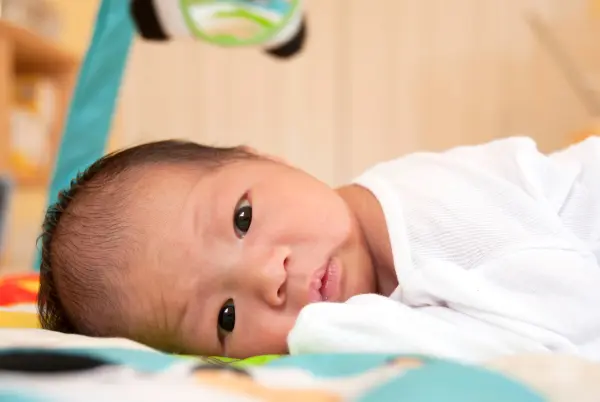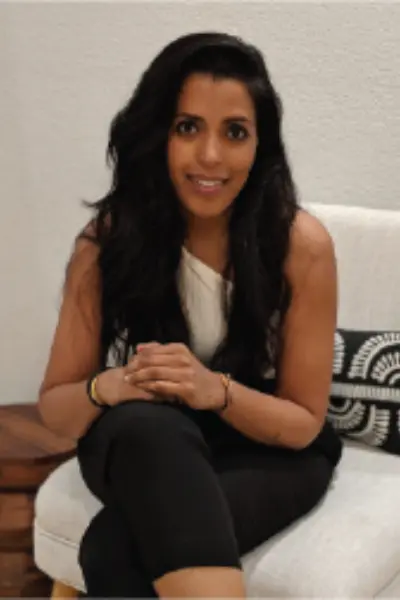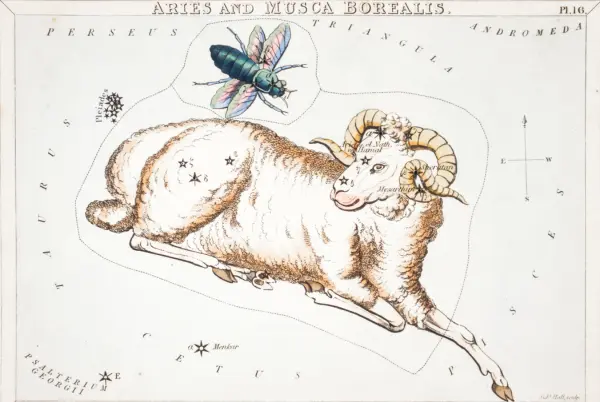Can My Newborn See Me? The Ultimate Infant Vision Guide by Dr. Dash 👶👁️

We wait nine months to see our little miracle, wondering who’s nose they’ll have, what that newborn smell is like, and how they’ll feel snuggled up with us. But when the delivery day finally comes and you gaze lovingly at your newborn for the first time, you may find yourself wondering: “can my baby actually see me?”
My name is Dr. Dash, I’m a pediatric optometrist, professor, vision scientist, and mom. I’m going to break down some of the most common questions about newborn vision so you know what to expect when you first lay eyes on your bundle of joy!
Yes, their vision is blurry
It’s pretty well known these days that infant vision is blurry. But why is that? For nine months, your little one is cuddled up in a cozy, but dark, space. There isn’t much to see, so there’s no way for a baby to practice or “calibrate” their vision. Think of it like trying to focus a camera with the cap still on the lens. Impossible! When babies are born, they’re finally exposed to lights, shapes, and colors. It’s like the cap finally comes off the camera! Now, your baby can actually practice using their eyes as they absorb the world around them, which gets clearer and clearer every day.
So if everything is so blurry, how can they see me?
This is where things get really cool. The human brain is designed to recognize and process faces with more importance than objects. Babies know the people taking care of them are essential to their survival. From the start, their brains are able to recognize and locate faces (especially mom’s) way before the rest of the world becomes clear [1]. So, no matter how blurry everything else is, rest assured: they’re always looking for you!
Will my baby need glasses?
There’s a huge genetic component to needing glasses, so if you or your partner wear glasses, there is a strong likelihood your child will need them too [2]. But don’t worry! Contrary to what some people think, glasses are not a sign of weakness. A glasses prescription actually relates to the shape of someone’s eyes, not how “strong” their eyes are [3]. Just like we all come in different shapes and sizes, so do our eyes! If your eyeball is a little longer, shorter, or curvier than average, you probably need glasses. If you want to delay when your child starts to need glasses, the best thing to do is to take them outside! Research shows time spent outdoors can delay the start of nearsightedness, the most common reason children need glasses or contact lenses [4].
Do babies really only see black and white?
Babies are born with everything they need to see both black and white, and colors [5]. But because things are dark and there aren’t any colors to see in utero (remember the camera analogy from earlier), they haven’t been able to practice and develop that skill yet! That’s why babies need a little more time (about 4 months) for their color vision to kick into gear [6]. Before then, high contrast images (meaning, areas of bright next to areas of dark) are easiest for them to see. Learn more about how to pick toys that support your baby’s visual development here.
How to care for your baby’s eyes
Here are my top 5 tips for caring for your baby’s eyes in their earliest days!
Take them outside!
90 minutes of outdoor time a day has been shown to delay the start of nearsightedness [7]. And, you don’t have to do it all at once! Short walks, an afternoon picnic, or a stroll at the farmer’s market with your little one all count.
Wear sunglasses
Some of the thinnest skin in your body is found in your eyelids. Sunglasses protect your baby’s eyes and eyelids from harmful UV rays reducing the risk of skin cancers and cataracts [8]. If your baby won’t keep sunglasses on (which was the case with my son), try a wide brimmed hat for some extra shade.
Watch for white pupils
The pupil is the circular opening in the center of the colored part of your baby’s eyes. It should be dark (or sometimes red in pictures), but it should never be white [9]. If it is, talk to your child’s pediatrician or eye doctor.
Keep them clean!
The germs that cause pink eye or other eye infections usually get introduced from dirty hands [10]. Frequent hand washing, and cleaning your baby’s eyelids gently with baby shampoo and water during baths can prevent infections, styes, and other eye conditions.
Get an eye exam
A baby should have their first eye exam between the ages of 6-12 months of age [11]. While your baby’s pediatrician has the ability to screen for major issues, an evaluation by a pediatric optometrist or ophthalmologist will be more comprehensive.
Fun facts to know as vision develops
- Babies only need to blink about 4 times per minute [12]. For reference, adults blink 20 times a minute! So, don’t challenge your baby to a staring contest!
- Speaking of blinking, prolonged screen time has been shown to reduce a child’s blink rate and lead to more dry eyes [13]. If a child of any age is using screens, the best thing to do is introduce breaks every few minutes to keep them blinking, and their eyes hydrated. A break can be as simple as getting up to grab a snack or drink of water!
- Black and white toys don’t actually make your child’s vision clearer, but they do help with increasing attention spans and stabilizing eye movements. Check this out in action with Smartbaby Decor’s award-winning, high contrast newborn yoga mat here.
- It’s totally normal for a newborn’s eyes to wander around! Learn more about newborn eye movements here.
- It’s also normal for eye color to change over time. Sometimes it takes almost 3 years for a baby’s eye color to reach its final hue [14].
- 80% of classroom learning is visual, and up to 40% of children thought to have a learning disability actually have a vision condition impeding their ability to reach their potential [15].
- The term “lazy eye” refers to many different conditions and can be really hard to detect, especially because a baby can’t tell you their vision is blurry. The best way to find out if your child has “lazy eye” is with a complete eye exam.
- Young children can wear contact lenses safely, and actually tend to get fewer infections than adults! In some cases, contact lenses are much more effective than glasses and lead to improved self-esteem [16]. Your child’s eye care provider will help determine if they are a good candidate for contact lenses.
- Finally, it takes years for children to develop all their visual skills. A child usually won’t develop normal 20/20 vision until they are about 5 years old [17], so be patient, they’ll get there!
Meet Dr. Dash

Dr. Dash is a residency-trained, pediatric optometrist with a Master's degree in molecular biology and a Fellowship of the American Academy of Optometry. She spent over a decade as a professor of pediatric vision, research scientist, and the later part of her career as the director of a community eye clinic. She founded Smartbaby Decor to bring her knowledge of visual development into any home so parents can create an amazing space for their child no matter how they see. Connect with her on social media @smartbabydecor or by email at contact@smartbabydecor.com. Learn more about infant vision by visiting her blog here.
References
- Bushnell, I. W. R. (2001). Mother’s face recognition in newborn infants: learning and memory. Infant and Child Development, 10, 67-74.
- Yu L, Li ZK, Gao JR, Liu JR, Xu CT. Epidemiology, genetics and treatments for myopia. Int J Ophthalmol. 2011;4(6):658-69. doi: 10.3980/j.issn.2222-3959.2011.06.17. Epub 2011 Dec 18. PMID: 22553740; PMCID: PMC3340784.
- Park SH, Park KH, Kim JM, Choi CY. Relation between axial length and ocular parameters. Ophthalmologica. 2010 Apr 1;224(3):188-93.
- Zhang J, Deng G. Protective effects of increased outdoor time against myopia: a review. Journal of International Medical Research. 2019;48(3). doi:10.1177/0300060519893866
- Kenneth Knoblauch, Michelle L. Bieber, John S. Werner. M- and L-cones in early infancy: I. VEP responses to receptor-isolating stimuli at 4- and 8-weeks of age. Vision Research, Volume 38, Issue 12, 1998, Pages 1753-1764, ISSN 0042-6989
- Skelton, A. E., Maule, J., & Franklin, A. (2022). Infant color perception: Insight into perceptual development. Child Development Perspectives, 16, 90–95. https://doi.org/10.1111/cdep.12447
- He M, Xiang F, Zeng Y, et al. Effect of Time Spent Outdoors at School on the Development of Myopia Among Children in China: A Randomized Clinical Trial. JAMA. 2015;314(11):1142–1148. doi:10.1001/jama.2015.10803
- Yam, J.C.S., Kwok, A.K.H. Ultraviolet light and ocular diseases. Int Ophthalmol 34, 383–400 (2014). https://doi.org/10.1007/s10792-013-9791-x
- Kanukollu VM, Tripathy K. Leukocoria. In: StatPearls. StatPearls Publishing, Treasure Island (FL); 2025. PMID: 32809629.
- Leung AK, Hon KL, Wong AH, Wong AS. Bacterial conjunctivitis in childhood: etiology, clinical manifestations, diagnosis, and management. Recent patents on inflammation & allergy drug discovery. 2018 Oct 1;12(2):120-7.
- American Academy of Ophthalmology. Children eye screening – tips & prevention [Internet]. San Francisco (CA): American Academy of Ophthalmology; [cited 2025 Sep 18]. Available from: https://www.aao.org/eye-health/tips-prevention/children-eye-screening
- SUGIYAMA T, TADA H. Toward normative values of blink activities for differences across age groups (Doctoral dissertation, Tohoku University).
- Muntz A, Turnbull PR, Kim AD, Gokul A, Wong D, Tsay TS, Zhao K, Zhang S, Kingsnorth A, Wolffsohn JS, Craig JP. Extended screen time and dry eye in youth. Contact Lens and Anterior Eye. 2022 Oct 1;45(5):101541.
- Sturm, R.A. and Larsson, M. (2009), Genetics of human iris colour and patterns. Pigment Cell & Melanoma Research, 22: 544-562. https://doi.org/10.1111/j.1755-148X.2009.00606.x
- Bullimore, Mark A.*. The Safety of Soft Contact Lenses in Children. Optometry and Vision Science 94(6):p 638-646, June 2017. | DOI: 10.1097/OPX.0000000000001078
- Leat SJ, Yadav NK, Irving EL. Development of visual acuity and contrast sensitivity in children. Journal of optometry. 2009 Jan 1;2(1):19-26.
- The Cooper Institute. Vision and Learning are Linked: What You Need to Know [Internet]. Dallas (TX): The Cooper Institute; 2022 Aug 3 [cited 2025 Sep 28]. Available from: https://www.cooperinstitute.org/blog/vision-and-learning-are-linked
{{trendingoffer}}
{{subscribe}}
Thank you for being part of the Villie family 💜





